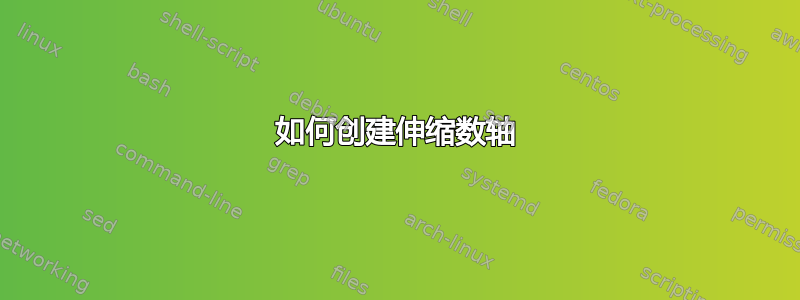
我想使用 tikz 或其他方式制作类似于上面的图形。
这是我的一行代码:
\tikzstyle{arrow} = [thick,<->,>=stealth]
\begin{tikzpicture}
\draw [arrow] (-2.5,0) -- (2.5,0);
\foreach \x in {-2,-1,0,1,2}
\draw[shift={(\x,0)},color=black] (0pt,3pt) -- (0pt,-3pt);
\foreach \x in {-2,-1,0,1,2}
\draw[shift={(\x,0)},color=black] (0pt,0pt) -- (0pt,-3pt) node[below] {$\x$};
\end{tikzpicture}
我如何垂直对齐它们?如果可能的话,我希望“缩放”为水平括号 ({)。
答案1
虽然这个问题把大部分精力留给了答题者,但在我看来,它有一个有趣的方面:画不对称的水平括号,即括号的“尖端”不在中心。也许已经用装饰完成了。然而,还有一种替代方法:使用这个非常好的答案通过特殊的箭头绘制括号。这样可以将箭头放在任何位置(或多或少,但不能太靠近括号的末端)。至于排列较小数字线的问题,可以使用矩阵。
\documentclass[tikz,border=3mm]{standalone}
\usepackage{mathtools}
\usetikzlibrary{arrows.meta,calc}
\pgfdeclarearrow{% https://tex.stackexchange.com/a/493083/194703
name=Brace tip,
parameters = {%
\the\pgfarrowlength
\the\pgfarrowlinewidth
},
setup code = {
\pgfarrowssettipend{.5\pgfarrowlength}
\pgfarrowssetlineend{-.45\pgfarrowlength}
\pgfarrowssetvisualbackend{-.5\pgfarrowlength}
\pgfarrowssetbackend{-.5\pgfarrowlength}
\pgfarrowshullpoint{.5\pgfarrowlength}{.5\pgfarrowlength}
\pgfarrowshullpoint{.5\pgfarrowlength}{-.5\pgflinewidth}
\pgfarrowshullpoint{-.5\pgfarrowlength}{.5\pgflinewidth}
\pgfarrowshullpoint{-.5\pgfarrowlength}{-.5\pgflinewidth}
\pgfarrowssavethe\pgfarrowlength
},
drawing code = {
\pgfpathmoveto{\pgfqpoint{-.5\pgfarrowlength}{.5\pgflinewidth}}%
\pgfpathcurveto%
{\pgfqpoint{.2\pgfarrowlength}{.5\pgflinewidth}}%
{\pgfpoint{.5\pgfarrowlength-.25\pgflinewidth}{.05\pgfarrowlength}}%
{\pgfpoint{.5\pgfarrowlength}{.5\pgfarrowlength}}%
\pgfpathcurveto%
{\pgfpoint{.5\pgfarrowlength+.25\pgflinewidth}{.05\pgfarrowlength}}%
{\pgfqpoint{.2\pgfarrowlength}{-.5\pgflinewidth}}%
{\pgfqpoint{-.5\pgfarrowlength}{-.5\pgflinewidth}}%
\pgfpathlineto{\pgfqpoint{-.5\pgfarrowlength}{.5\pgflinewidth}}
\pgfpathclose
\pgfusepathqfill
},
defaults = {
length = .5cm,
}
}
\begin{document}
\begin{tikzpicture}[node font=\scriptsize,nodes={text depth=0.25ex,text height=0.6em}]
% arrange the smaller number lines in a matrix.
% Matrices work almost like magic but not quite so we have to add some
% xshifts in the second column.
\matrix[column sep=5mm] (mat){
\draw[cyan] (-4.2,0) coordinate(L1) -- (4.2,0) coordinate(R1)
foreach \X in {-4,...,4}
{(\X,-0.1) coordinate (a\X)-- (\X,0.1) node[above]{$\ifnum\X<0\relax
\mathllap{-}\the\numexpr-1*\X\relax\else\X\fi$}};
&
\draw[cyan,xshift=2cm] (-1.2,0) coordinate(L2) -- (2.2,0)coordinate(R2)
foreach \X in {-1,...,2}
{(\X,-0.1) coordinate (b\X) -- (\X,0.1) node[anchor=south west,
xshift={-width("2")-width("$\omega$")/2-2pt}
]
{$2\omega\ifnum\X<0 \X\else\ifnum\X>0+\X\fi\fi$}};
\\[2em]
\draw[magenta,xscale=0.8] (-5.2,0) coordinate(L3) -- (5.2,0) coordinate(R3)
foreach \X in {-5,...,5}
{(\X,-0.1) -- (\X,0.1) node[above]{$\ifnum\X<0\relax
\mathllap{-}\the\numexpr-1*\X\relax\varepsilon\else\ifnum\X=0\relax0
\else\X\varepsilon\fi\fi$}};
&
\draw[magenta,xscale=0.8,xshift=3.5cm] (-2.5,0) coordinate(L4) -- (1.5,0)coordinate(R4)
foreach \X in {-2,...,1}
{\ifodd\X
(\X,0.1) -- (\X,-0.1) node[below]
{$2\omega+1\ifcase\the\numexpr\X+2\relax
-2\varepsilon
\or
-\varepsilon
\or
\or
+\varepsilon
\fi$}
\else
(\X,-0.1) -- (\X,0.1) node[above]
{$2\omega+1\ifcase\the\numexpr\X+2\relax
-2\varepsilon
\or
-\varepsilon
\or
\or
+\varepsilon
\fi$}
\fi};
\\
};
% some auxiliary coordinates
\path (L1) -- (L3) coordinate[pos=0.3] (M1)
(current bounding box.north west) coordinate
(NW) (current bounding box.north east) coordinate (NE);
% draw master number line by measuring the distance between the
% two zero locations
\draw let \p1=($(b0)-(a0)$) in
[shift={([yshift=0.6cm]NW-|a0)},x={\x1/2}]
(-1.2,0) --(3.2,0)
foreach \X in {-1,...,3}
{(\X,-0.1) coordinate (x\X)
-- ++ (0,0.2) node[above]{$\ifnum\X<0\relax
\mathllap{-}\omega\relax\else\ifnum\X=0\relax0\else\X\omega\fi\fi$}}
(0.5,0.1) node[above,red]{$\frac{\omega}{2}$} edge[red] ++ (0,-0.1)
({sqrt(7)},0.1) node[above,red]{$\sqrt{7}\omega$} edge[red] ++ (0,-0.1)
;
\path (x0) -- (L1) coordinate[pos=0.3] (M0);
% braces using https://tex.stackexchange.com/a/493083/194703
\draw[Brace tip-Brace tip,very thick] (L1|-M0) -- (x0|-M0);
\draw[{Brace tip[swap]}-{Brace tip[swap]},very thick] (x0|-M0) -- (R1|-M0);
\draw[Brace tip-Brace tip,very thick] (L2|-M0) -- (x2|-M0);
\draw[{Brace tip[swap]}-{Brace tip[swap]},very thick] (x2|-M0) -- (R2|-M0);
\draw[Brace tip-Brace tip,very thick] (L3|-M1) -- (a0|-M1);
\draw[{Brace tip[swap]}-{Brace tip[swap]},very thick] (a0|-M1) -- (R3|-M1);
\draw[Brace tip-Brace tip,very thick] (L4|-M1) -- (b1|-M1);
\draw[{Brace tip[swap]}-{Brace tip[swap]},very thick] (b1|-M1) -- (R4|-M1);
\end{tikzpicture}
\end{document}




